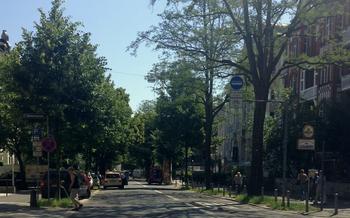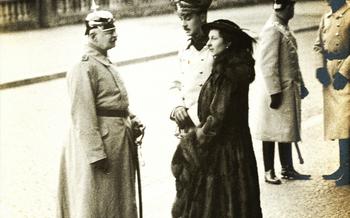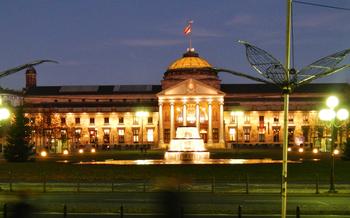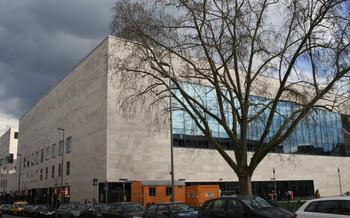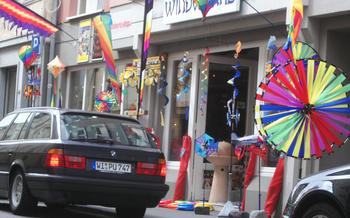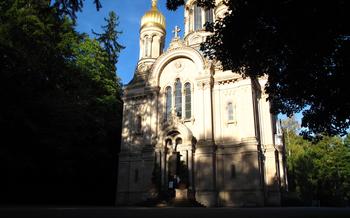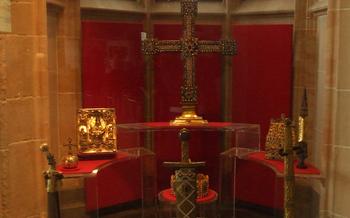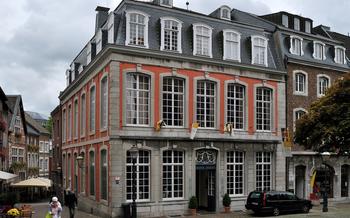
The New Town Hall
- Orientation and Background
- The New Town Hall: A Symbol of Wiesbaden's Grandeur
- Guided Tours and Accessibility
- The Tower
- The Chimes
- The Carillon
- Art and Culture
- The Courtyard
- The City Archives
- The Citizens' Hall
- The Fountain Courtyard: A Work of Art and Ingenuity
- The Römertor: A Connection Between History and Modernity
- Insider Tip: Best Time to Visit
Orientation and Background
Wiesbaden, the capital city of the German state of Hesse, boasts a rich history dating back to Roman times, renowned for its thermal springs and elegant architecture. In the 19th century, Wiesbaden underwent a remarkable transformation, evolving from a spa town to a modern metropolis. This vibrant city seamlessly blends its historical charm with contemporary advancements, showcasing a diverse range of architectural styles, from Neoclassical to Art Nouveau. Wiesbaden's strategic location in the heart of Germany, easily accessible by train, car, or plane, makes it a convenient destination for travelers from across the country and beyond. Its proximity to major cities like Frankfurt and Mainz further enhances its appeal as a tourist destination.
The New Town Hall: A Symbol of Wiesbaden's Grandeur
The New Town Hall, also known as the Rathaus, stands as a magnificent testament to Wiesbaden's rich history and architectural prowess. Constructed between 1884 and 1887 by architects Friedrich von Thiersch and Eduard Zais, this opulent building showcases an eclectic blend of architectural styles, including Neo-Renaissance, Neo-Gothic, and Neo-Baroque. Its striking façade, adorned with intricate carvings, sculptures, and stained-glass windows, is an awe-inspiring sight that instantly captivates visitors.
The interior of the New Town Hall is equally impressive, boasting grand staircases, vaulted ceilings, and ornate chandeliers. The building's numerous rooms and halls serve various public functions, including council meetings, civil ceremonies, art exhibitions, and cultural events. The Grand Hall, with its towering pillars and elaborate frescoes, is a particularly breathtaking space that hosts prestigious receptions and official ceremonies.
The New Town Hall's 56-meter-high tower offers panoramic views of Wiesbaden and the picturesque Taunus Mountains. Visitors can ascend the tower's narrow staircase or take the elevator to the observation deck, where they are rewarded with breathtaking vistas of the city and its surroundings.
Guided Tours and Accessibility
Guided Tours
For a deeper understanding of the New Town Hall's history, architecture, and significance, guided tours are highly recommended. These tours are conducted by knowledgeable guides who provide insights into the building's construction, unique features, and its role in Wiesbaden's civic life. Guided tours are available in German and English, and reservations can be made in advance through the Wiesbaden Tourist Information Center.
Accessibility
The New Town Hall is committed to providing an inclusive and accessible environment for all visitors. The building is wheelchair accessible, with ramps and elevators available to reach all floors. Additionally, there are designated parking spaces for disabled visitors, and the information desk is equipped with assistive listening devices for the hearing impaired. The New Town Hall's website also offers a virtual tour, allowing those unable to visit in person to experience the building's grandeur and history from the comfort of their own homes.
The Tower
The New Town Hall's tower, a striking landmark visible from various points in Wiesbaden, offers breathtaking panoramic views of the city and the picturesque countryside beyond. Ascending the tower's 153 steps rewards visitors with unparalleled vistas that stretch across the Rhine Valley, encompassing the lush vineyards, rolling hills, and the majestic Taunus Mountains.
On a clear day, the panorama extends as far as the Frankfurt skyline, with its iconic skyscrapers piercing the horizon. The tower's observation deck provides ample space for visitors to soak in the stunning scenery and capture memorable photographs.
Beyond its scenic allure, the tower holds historical significance. Built in 1897, it initially served as a fire watchtower, with a dedicated watchman tasked with spotting fires and raising the alarm. Today, the tower stands as a symbol of Wiesbaden's rich heritage and its transformation from a humble spa town to a thriving modern metropolis.
The Chimes
The New Town Hall is renowned for its unique chimes and glockenspiel, which have become iconic symbols of Wiesbaden. The chimes, consisting of 45 bells, play a variety of melodies throughout the day, filling the air with their harmonious sounds. The glockenspiel, on the other hand, is a mechanical musical instrument composed of 37 bells that perform pre-programmed melodies.
The history of the chimes and glockenspiel dates back to the early 20th century when they were installed as part of the New Town Hall's construction. The melodies played by the chimes and glockenspiel are carefully selected and often include traditional German folk songs, classical pieces, and contemporary compositions.
The chimes and glockenspiel performances take place at specific times throughout the day, attracting both locals and tourists alike. Visitors can gather in the square in front of the New Town Hall to listen to the enchanting melodies and witness the spectacle of the glockenspiel's moving figures.
Additionally, the New Town Hall hosts special events and concerts featuring the chimes and glockenspiel. These events often showcase the talents of renowned musicians and composers who create unique and captivating performances. Whether you're a music enthusiast or simply looking for a memorable experience, attending a chimes or glockenspiel concert at the New Town Hall is a must-do in Wiesbaden.
The Carillon
The New Town Hall boasts a magnificent carillon, a musical instrument composed of a set of bells that are played by a keyboard. With its origins in the Low Countries, the carillon has become an iconic symbol of civic pride and cultural heritage in many European cities.
The carillon at the New Town Hall is a remarkable instrument, consisting of 49 bells, ranging in weight from a mere 7 kilograms to an impressive 5 tons. These bells are arranged in a carefully calibrated sequence, allowing for a wide range of melodies and harmonies to be played. The carillonneur, a skilled musician, operates the instrument from a special keyboard located in the tower.
Regular carillon concerts are held at the New Town Hall, showcasing the talents of renowned carillonneurs from around the world. These concerts offer a unique opportunity to experience the enchanting sounds of the carillon, as the melodies float across the city, captivating audiences with their beauty and charm.
Art and Culture
The New Town Hall is not just a seat of local government but also a vibrant cultural hub. The building hosts a variety of art exhibitions throughout the year, showcasing the works of both local and international artists. These exhibitions cover a wide range of artistic styles and genres, from traditional paintings and sculptures to contemporary installations and multimedia displays.
In addition to art exhibitions, the New Town Hall also hosts a variety of other cultural events and programs. These events include lectures, workshops, concerts, and performances, all of which are open to the public. The topics covered in these events are diverse, ranging from history and politics to music and literature.
The New Town Hall's commitment to art and culture is a reflection of Wiesbaden's rich cultural heritage. The city has a long history of supporting the arts, and the New Town Hall is a testament to that commitment. Whether you are a local resident or a visitor, you are sure to find something of interest at the New Town Hall's cultural events.
The Courtyard
The New Town Hall's courtyard is not merely an architectural feature but also a significant public space that serves various purposes. Historically, the courtyard played a crucial role in civic ceremonies and events, providing a grand setting for official gatherings, celebrations, and public announcements.
Today, the courtyard continues to be a vibrant public space, inviting locals and visitors alike to relax, socialize, and enjoy the surroundings. Whether seeking a quiet moment of contemplation or engaging in lively conversations, the courtyard offers a welcoming ambiance for all.
Special events and exhibitions are often held in the courtyard, transforming it into a lively hub of activity. From art installations and cultural performances to seasonal markets and festivals, the courtyard provides a dynamic platform for Wiesbaden's vibrant arts and cultural scene.
The City Archives
The City Archives, housed within the New Town Hall, stand as a treasure trove of Wiesbaden's rich history, preserving a vast collection of documents, maps, and photographs that chronicle the city's past. These archives serve as a valuable resource for researchers, historians, and anyone seeking to delve deeper into the city's heritage.
Within the City Archives, visitors can explore a wealth of historical documents dating back to the Middle Ages, providing insights into Wiesbaden's political, economic, and social development over the centuries. Researchers can access a diverse range of materials, including city council records, legal documents, and personal papers, offering a glimpse into the lives of Wiesbaden's citizens throughout history.
The City Archives also house an extensive collection of maps and plans, showcasing the city's urban development and transformation over time. These maps provide a visual representation of Wiesbaden's growth, from its humble beginnings to its emergence as a modern metropolis.
Furthermore, the City Archives offer a collection of photographs capturing Wiesbaden's architectural heritage, everyday life, and significant events. These images provide a vivid glimpse into the city's past, allowing visitors to witness the transformation of Wiesbaden's streets, landmarks, and people through the lens of time.
Whether you're a history buff, a researcher, or simply curious about Wiesbaden's past, the City Archives offer a fascinating journey through time, preserving the city's rich heritage for generations to come.
The Citizens' Hall
The Citizens' Hall is a grand and historic venue within the New Town Hall that serves as a platform for public gatherings, meetings, and events. This impressive hall has witnessed countless significant moments in Wiesbaden's history. Its elegant décor, spacious layout, and state-of-the-art facilities make it an ideal setting for various functions, from political debates and community meetings to cultural performances and festive celebrations.
Throughout the years, the Citizens' Hall has played a crucial role in fostering civic engagement and facilitating dialogue among the people of Wiesbaden. Notable historical events, such as speeches by prominent figures and debates on important city matters, have taken place within its walls. The hall's rich history and symbolic significance continue to make it a cherished venue for public events that shape the city's identity and community spirit.
The Fountain Courtyard: A Work of Art and Ingenuity
The Fountain Courtyard stands as a remarkable architectural masterpiece within the New Town Hall complex. Its ornate fountain, adorned with intricate sculptures, serves as a captivating centerpiece, drawing the eye with its beauty and grandeur. The courtyard's design seamlessly blends historical charm with modern functionality, creating a harmonious space that invites both contemplation and admiration.
Beyond its aesthetic allure, the Fountain Courtyard holds historical significance. It once played a crucial role in the city's water supply, providing a vital source of fresh water for Wiesbaden's growing population. The fountain's construction symbolized the city's commitment to urban development and modernization, reflecting the progressive spirit that shaped Wiesbaden's transformation into a thriving metropolis.
Today, the Fountain Courtyard stands as a testament to the city's rich heritage and its enduring connection to water. It serves as a tranquil oasis amidst the bustling city center, offering visitors a place to pause, reflect, and appreciate the beauty of this architectural gem.
The Römertor: A Connection Between History and Modernity
The Römertor, meaning "Roman Gate," stands as a testament to Wiesbaden's rich history. This preserved section of the city's medieval fortifications serves as a striking reminder of Wiesbaden's past as a Roman settlement. The Römertor once formed part of the city's defensive wall, protecting its inhabitants from potential threats.
Today, the Römertor serves as a symbolic connection between the Old Town and the New Town Hall, representing the harmonious blend of Wiesbaden's past and present. The gate's sturdy stone construction and intricate carvings speak of a time long gone, while its proximity to the modern New Town Hall symbolizes the city's continuous evolution.
Visitors can stroll through the Römertor, immersing themselves in its historical significance and admiring the architectural details that have stood the test of time. This iconic gateway offers a unique glimpse into Wiesbaden's fascinating past, inviting travelers to explore the city's rich cultural heritage.
Whether you're a history buff, an architecture enthusiast, or simply curious about Wiesbaden's roots, the Römertor is a must-visit destination. Step through its ancient archway and let the city's past come alive as you journey through time.
Insider Tip: Best Time to Visit
To fully appreciate the beauty and significance of the New Town Hall, plan your visit wisely. The best time to visit Wiesbaden is during the warmer months, from May to September, when the weather is pleasant and the city is bustling with activity. During this time, you can take advantage of the outdoor cafés and restaurants in the surrounding area, enjoying a meal or a drink while admiring the stunning architecture. Additionally, various festivals and events are held throughout the summer, offering a chance to immerse yourself in Wiesbaden's vibrant culture.
